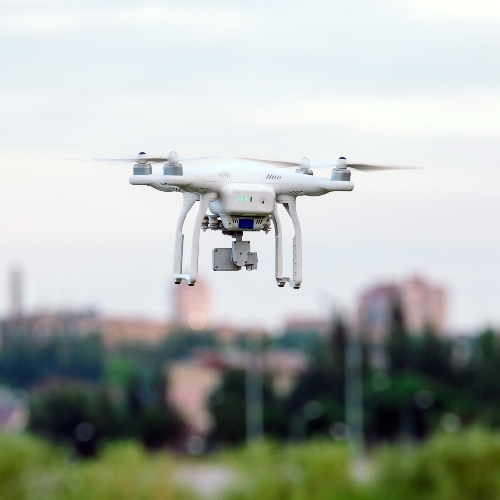5G players reassess the drone opportunity
A new FCC proposal would set aside the 5030MHz-5091MHz band exclusively for drones and other Unmanned Aircraft Systems (UAS). Meaning, drone pilots wouldn't need 5G.

Network operator executives often talk about drones in the same breath as cars, robots and VR goggles when boasting of the gadgets that will eventually connect to 5G networks – and thereby generate new 5G revenues.
But a new FCC proceeding is sparking some navel-gazing about the revenues that might come from 5G connections to drones. The proceeding seeks to allocate a relatively small slice of spectrum in the 5GHz band directly to Unmanned Aircraft Systems (UAS), or drones.
If the FCC moves forward on the topic, there is a chance that some drone operators will be satisfied with their new UAS-specific spectrum – no 5G necessary.
In response, some 5G players are asking for new FCC rules that could allow them to better service drones and other airborne business opportunities. Meanwhile, others are hoping drone companies eventually purchase the management technologies initially developed in the 5G industry.
Broadly, the situation helps to underscore the maturation of the drone market. And it stands as yet another complication to big 5G players that want to eventually connect everything to their new, high-speed networks.
A place to call home
Earlier this year, the FCC proposed new rules that would set aside the 5030MHz-5091MHz band for drones and other unmanned aircraft systems. Such gadgets today primarily operate on unlicensed and low-power wireless systems, or on experimental spectrum licenses.
"It is past time that we assess the availability of wireless communications resources for the increasingly important remote-piloted aircraft activity we rely on today," FCC Chairwoman Jessica Rosenworcel said at the time. "The FCC must ensure that our spectrum rules meet the current – and future – spectrum needs of evolving technologies such as unmanned aircraft systems, which can be critical to disaster recovery, first responder rescue efforts, and wildfire management."
Since then, companies from the drone, technology, utility and 5G industry have been submitting their opinions on how the FCC might move forward.
In general, most companies cheered the FCC's proposal – but they also argued that the agency should not restrict drone communications exclusively to the 5030MHz-5091MHz band.
"Given the diverse and multifaceted nature of the UAS industry, the use of all appropriate bands, including flexible-use spectrum, is essential for allowing a variety of different UAS operating models to continue benefiting from this spectrum. This freedom to choose the frequency that is best suited to each UAS concept of operations has enabled unprecedented innovation in the development of UAS operations and services," wrote the Small UAV Coalition in recent comments to the FCC.
Most big 5G players agreed.
"The commission should permit the use of all terrestrial mobile flexible-use spectrum bands to support UAS operations, so long as that use does not interfere with other terrestrial licensees," T-Mobile wrote to the FCC.
Meaning, the 5030MHz-5091MHz band is great, but drone operators should also be allowed to use T-Mobile's 5G network when appropriate.
Indeed, the Drone Racing League told the FCC that it currently uses spectrum below 1GHz for its operations, and that switching to the 5GHz band would be "cost-prohibitive."
Looking for opportunities
It comes as no surprise that some big 5G companies sought to use the FCC's proceeding to drum up some regulations that would be favorable to their own respective businesses.
For example, AT&T, Verizon and T-Mobile all urged the FCC to ease its restrictions around the 800MHz band for drones. In general, they argued that current FCC rules prevent them from using their 800MHz holdings to broadcast signals to some aircraft.
"The commission imposed airborne-use prohibitions on flexible-use spectrum decades ago based on interference concerns that have not borne out," Verizon wrote to the FCC. "These prohibitions not only create inefficient spectrum use, but also hinder UAS innovation and wireless licensees' ability to meet customer needs."
AT&T agreed. "AT&T has ... had to forego other opportunities due to the airborne use prohibition for the 850MHz band," it wrote.
AT&T, Verizon and others argued for new FCC rules that would remove restrictions on transmissions to airborne gadgets like drones.
Finally, Qualcomm outlined a proposal that would transfer into the drone industry some of the technologies it's working to develop for the automotive market. Specifically, the vendor told the FCC to consider setting aside some spectrum for "direct unmanned-aircraft-to-unmanned-aircraft ("UA-to-UA") detection and collision avoidance."
That kind of vehicle-to-vehicle (V2V) communication technology might be familiar to those in the wireless industry. After all, Qualcomm and a variety of other players have been pushing the concept of vehicle-to-everything (V2X) in the automotive industry for years. Such technology promises to allow cars to communicate with each other and with objects in their surroundings, like stoplights, in order to prevent accidents.
Related posts:
— Mike Dano, Editorial Director, 5G & Mobile Strategies, Light Reading | @mikeddano
About the Author(s)
You May Also Like











